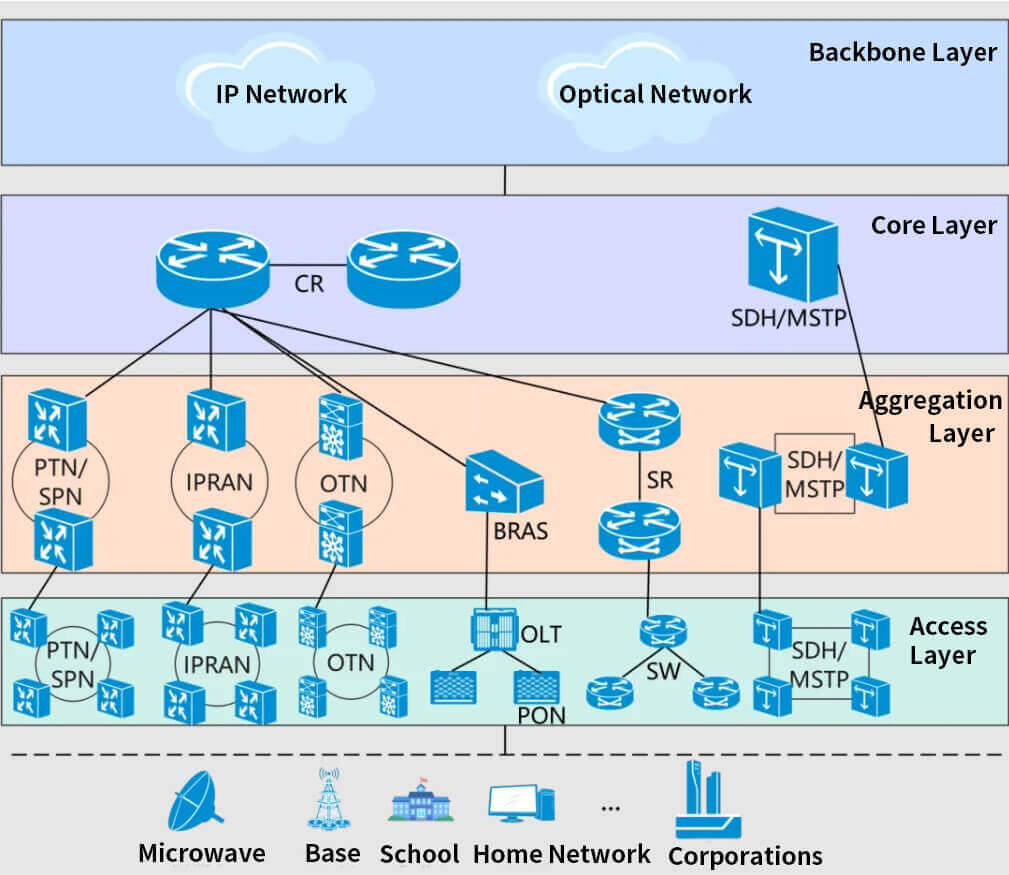1. What Is Bearer Networks
The bearer network is the network used to carry data for various services, which can be the backbone network of the operator or the internal network of the enterprise. The main task of the bearer network is to provide stable, reliable and efficient data transmission services for various services.
In short, it is a network structure used to transmit and carry information. If the bearer network is compared to a highway, the data is like a vehicle, speeding on this highway, passing from one place to another, to meet the needs of a variety of business data transmission.

The bearer network has been called the “invisible hero” of the Internet of Everything for the following reasons.
A. Universality And Fundamentality
The existence of the bearer network as an infrastructure that connects various networks and data is universal and fundamental. Both individual users and corporate organizations rely on bearer networks for data transmission and exchange in their daily lives and work. The bearer network is like the road system of a city, supporting various activities.
B. Transparency And Non-perception
The bearer network usually plays the role of a “behind-the-scenes hero” between the user and the device. Most users do not directly perceive the existence of the bearer network when using Internet services. However, it is the efficient and stable operation of the bearer network that enables a variety of services to be carried out smoothly, so that users can enjoy a seamless network experience.
C. Ability To Connect Everything
The bearer network connects not only human-to-human communications, but also a wide variety of entities such as IoT devices, data centers, and cloud computing platforms. It enables various devices and systems to communicate and share information with each other, thus realizing an intelligent and connected society.
D. Continuous Evolution And Adaptation
With the continuous development of technology and changing business needs, the bearer network is also continuously evolving and upgrading. From early telephone line networks to modern fiber-optic networks, and from narrowband communications to broadband, mobile communications and the Internet of Things, the bearer network has always adapted to and met the growing demand for communications.
E. Supporting Socio-economic Development
As the infrastructure of the information society, the carrier network plays an important supporting role for socio-economic development. It promotes the circulation and sharing of information, accelerates industrial upgrading and innovation, and injects new vitality into economic development.
What are the types of bearer networks?
Based on the transmission medium, the bearer network can be divided into the following three categories.
- Fiber-optic bearer networks: Using optical fiber as transmission medium, it provides high bandwidth and low latency data transmission.
- Copper Carrier Networks: Uses copper wires as transmission medium and is suitable for short distance and low speed data transmission.
- Wireless Bearer Network: Uses wireless communication technology (e.g. microwave, satellite, etc.) for data transmission, suitable for scenarios where cabling is not easy or flexible deployment is required.
By type of business, the bearer network can be divided into the following three categories.
- Fixed bearer network: It mainly carries fixed services such as fixed telephony and broadband Internet.
- Mobile bearer network: It mainly carries mobile services such as cell phone and mobile data.
- Multimedia bearer network: Capable of carrying multiple media services such as voice, video and data at the same time.
By type of coverage, the bearer network can be divided into the following three categories.
- Local bearer network (LBN): Coverage of smaller geographic areas, such as cities or campuses.
- Long distance bearer network: Connects networks in different regions to enable data transfer across regions.
- International bearer network: Connecting networks in different countries for international data transfer.
By type of technological infrastructure, the bearer network can be divided into the following three categories.
- Circuit-switched bearer network (CSCN): Based on circuit-switched technology, it provides stable connectivity and fixed bandwidth.
- Packet-switched bearer network (PSBN): Based on packet-switching technology (e.g., IP), it provides flexible data transmission and bandwidth allocation.
What is the architecture of the bearer network?
The architecture of a bearer network can vary according to different technical standards and application scenarios. In general, bearer networks are usually categorized into access, aggregation, core and backbone layers. These layers are functionally distinct and work together to realize data transmission and service bearing.

Access Layers
This is the segment of the bearer network closest to the user and is responsible for connecting the base station and other access devices, not only enabling the wireless signal to be transmitted to the user’s device, but also ensuring stable transmission of the wired signal. The rate of the access layer is usually low, similar to the internal road of XX company, which can accommodate a limited amount of traffic. In the 5G bearer network, the access layer is mainly responsible for connecting with user devices, including WiFi, cellular networks, home broadband and other access methods.
Aggregation Layers
Similar to a city’s main road, multiple smaller roads converge to form one big road that can accommodate more traffic. The aggregation layer has a higher rate than the access layer and is responsible for aggregating and forwarding data traffic from the access layer. In a 5G bearer network, the aggregation layer not only provides network connectivity for backhaul, but also needs to provide network connectivity for the interfaces between some of the core network elements.
Core Layers
Similar to a city’s main road, it can meet the transmission needs of large amounts of data. In the 5G bearer network, the core layer is responsible for the control, data transmission and processing of the 5G network, including the core network control plane and user plane.
Backbone Layers
Similar to inter-provincial highways (e.g. Beijing-Hong Kong-Macao Expressway), including provincial trunks and national trunks. It is responsible for connecting various core layers and realizing cross-region and cross-operator data transmission. In the 5G bearer network, the backbone layer mainly provides network connectivity for the interfaces between some core network elements.
What transmission technologies are available for bearer networks?
There are various transmission technologies for bearer networks, including MSTP, PTN, IPRAN, OTN, ASON, WASON, MetroE, DCN, etc.
MSTP

With broadband Internet access, a large number of IP services and ATM business needs, so MSTP (Multi-Service Transport Platform, Multi-service Transport Platform) was born, MSTP is based on SDH increased Ethernet interface and ATM interface access functions.
If the SDH equipment is compared to a bridge, before the bridge is only one layer, can only run cars (TDM service), but later due to the traffic needs, the bridge will be expanded to two layers, in addition to running cars, but also can run trains (Eehernet service and ATM service), we will be such a bridge is called MSTP platform.
PTN

With the popularization of the Internet, the demand for bandwidth has increased dramatically, of which IP data is the strongest, many services are using IP packets for transmission. IP packets can be used as the traditional SDH (or MSTP) “goods”, but SDH “goods” shape requirements must be “block structure”, while IP frame length varies, using SDH will be too costly. However, SDH requires that the shape of the “goods” must be a “block structure”, while IP frame length varies, using SDH will cost too much.
PTN (Packet Transport Network, packet transport network) technology for the realization of efficient transportation of a variety of different goods, targeted production of different load-bearing capacity of the vehicle, such as the train transport oversized, car transport medium-sized pieces, bicycle transport small pieces. Practical applications are: larger transmission bandwidth for video files, slightly smaller bandwidth for audio files, and very small bandwidth for text files.
IPRAN

IPRAN (IP Radio Access Network) technology is a kind of IP-based mobile network formed by using routers as carrying tools. It is based on IP/MPLS protocols and key technologies, and is mainly oriented to mobile service bearer and also takes into account the provision of Layer 2 and Layer 3 channel service bearer, and is composed of end-to-end service bearer network relying on the backbone layer of CN2, with the province as the unit.
IPRAN technology, which is like a master of IP and MPLS protocols, can turn the complex mobile network into a simple, efficient and reliable transmission channel; it has the circuit emulation capability, which allows TDM services to be transmitted smoothly in the IP-based network; it has high reliability and protection capability, which is always ready to cope with all kinds of network failures; and it can monitor the network status in real time, which is very intelligent and reliable.
OTN

OTN is an optical transport network technology, based on WDM technology, in the ultra-large transmission capacity based on the introduction of SDH powerful operation, maintenance, management and assignment (OAM) capabilities.
OTN (Optical Transport Network, optical transport network) using embedded standard FEC, rich maintenance and management overhead, suitable for large-grain service access FEC error correction coding, improved BER performance, increased optical transmission span.
OTN is like a powerful “photonic courier”, can be a variety of data, whether it is text, pictures or video, all packaged into a “photonic package”, quickly and safely help you to the destination.
ASON

ASON (Automatic Switched Optical Network) is a kind of automatic switched transport network integrating switching and transmission.
We can compare ASON to a navigator. When we set up the destination, the navigator automatically shows several routes to the destination, we can choose a more familiar and well-traveled route according to the actual situation, if we temporarily change the route, the navigator will re-plan the new route until we reach the destination smoothly.
In fact, ASON is similar to this optical transmission network with navigation function. It can automatically discover the network topology, and after the user or the network management dynamically initiates the service request, it can automatically select the route and realize the establishment, modification and removal of the service connection through signaling notification.
WASON

WASON (WDM/OTN Automatically Switched Optical Network) is an automatically switched optical network based on WDM (wavelength division multiplexing) and OTN (optical transport network). It can be regarded as an intelligent optical network with automatic switching and transmission functions.
We can compare WASON to a robot with auto-switching and transmission functions that allow your data to automatically choose the best path during transmission to avoid congestion and delays. At the same time, it is also proficient in various protocols and signaling systems to ensure that your data is always stable and error-free during transmission.
MetroE

MetroE (Metro Ethernet) is a metropolitan area network (MAN) solution based on Ethernet technology, which is usually located between the access network and the backbone network, and plays the role of connection and aggregation. MetroE can also be connected to the IDC (Internet Data Center) through high-speed network connection to provide reliable Internet access and data transmission services for the IDC. reliable Internet access and data transmission services for IDCs.
MetroE: It is like the “traffic commander” in the MAN, based on Ethernet technology, quietly shuttling between the access network and the backbone network to ensure that the data can be smoothly transmitted from one place to another; it is also very reliable, providing stable and reliable Internet access and data transmission services for IDC through high-speed network connection.
DCN

DCN (Data Center Network), the internal network of data center, is mainly responsible for connecting computing, storage and management servers, which not only carries the north-south traffic of users accessing data center applications, but also is responsible for handling the east-west traffic of inter-server interaction. Take the current high-profile Smart Computing Center as an example, its network architecture is precisely based on a DCN implementation.
Applied in practice, the DCN is like a busy party organizer, responsible for the data center of a variety of servers, storage devices and other equipment are connected together to ensure that everyone can happily communicate. It also needs to work with the bearer network, the “diplomat,” to keep the data flowing both inside and outside the data center.
Each technology in the bearer network has its own unique characteristics and application scenarios. In practical applications, the appropriate technology is usually selected according to specific needs for networking and transmission. Meanwhile, with the continuous development of technology, more new transmission technologies may appear in the future, bringing more possibilities and surprises to our communication network.



